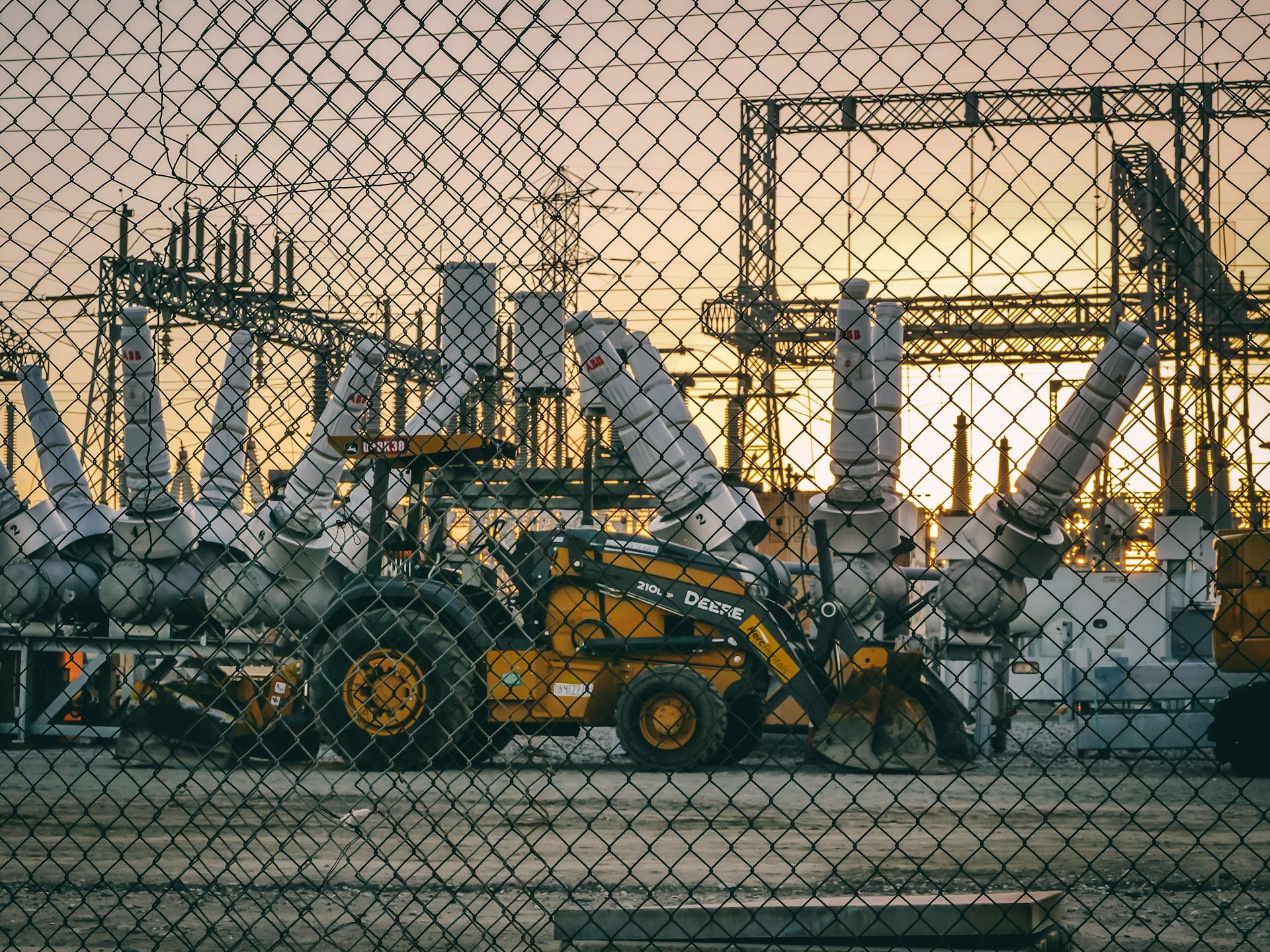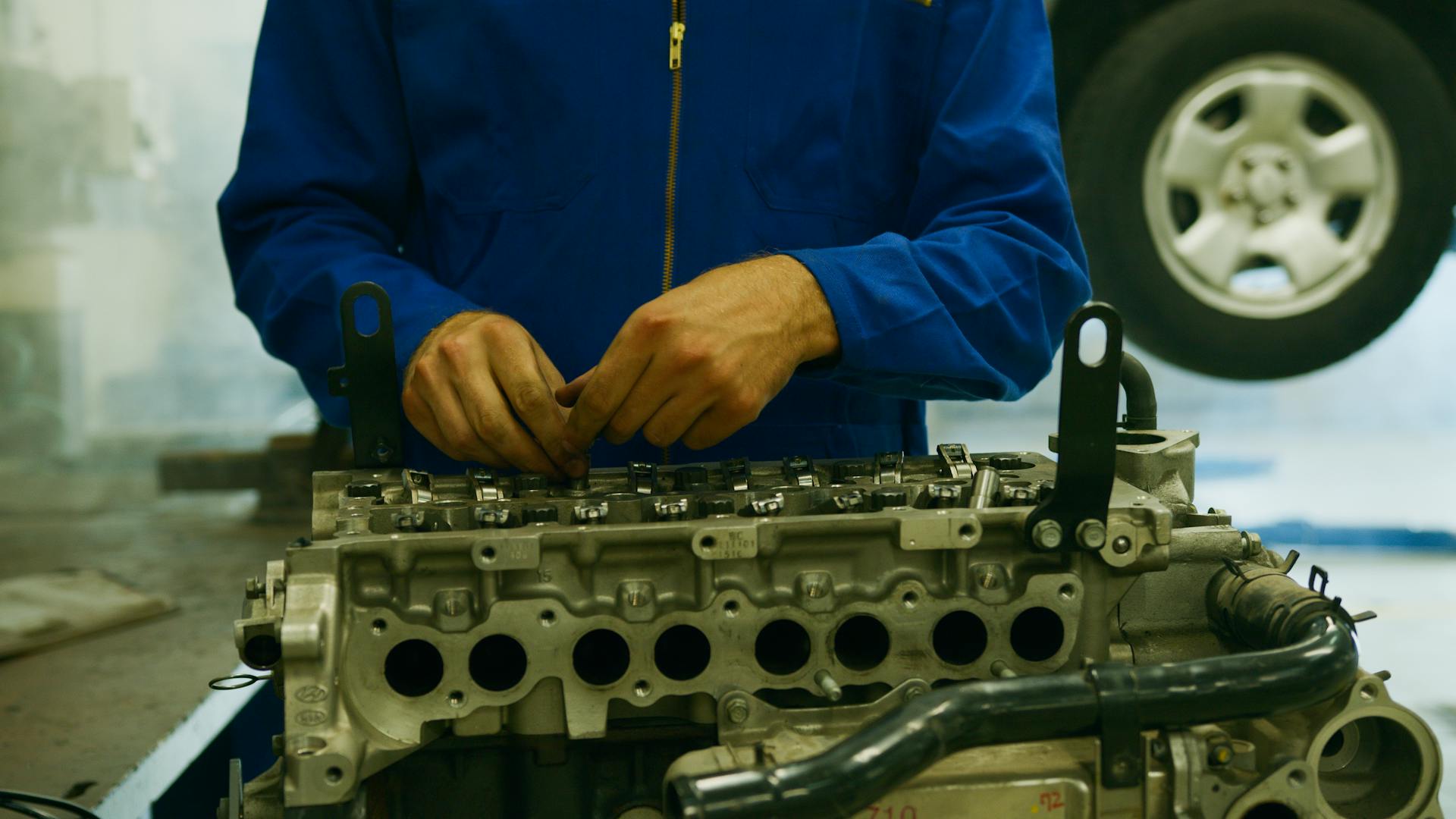
A DC generator is a type of electrical machine that converts mechanical energy into electrical energy in the form of direct current.
The main components of a DC generator include the field winding, armature, commutator, brushes, and bearings.
The field winding is typically made of copper wire and is responsible for producing the magnetic field that interacts with the armature.
The armature is a rotating component that consists of multiple coils of wire and is where the mechanical energy is converted into electrical energy.
The commutator is a mechanical device that reverses the direction of current flow in the armature coils as they rotate, ensuring a constant flow of direct current.
Brushes are used to make electrical contact with the commutator and are typically made of a conductive material such as graphite or carbon.
The bearings support the rotating components of the DC generator, allowing for smooth operation and minimizing friction.
Intriguing read: How Do Electrical Generators Work
Magnetic System
The magnetic system of a DC generator is a crucial component that produces the main magnetic flux. It's the stationary part of the machine.
The magnetic field system consists of the mainframe or yoke, pole core, pole shoes, and field or exciting coils. These parts work together to create the magnetic field.
The mainframe or yoke is the outer hollow cylindrical frame that supports the pole cores and provides mechanical protection to the inner parts of the machine. It's typically made of cast steel or rolled steel for large machines.
The yoke also provides a low reluctance path for the magnetic flux. This is important for efficient operation of the DC generator.
The two main purposes of the yoke are to support the pole cores and provide mechanical protection, and to provide a low reluctance path for the magnetic flux.
Armature and Commutator
The armature is the rotating part of a DC generator, consisting of a laminated cylinder called the armature core, which is keyed to the rotating shaft. The armature core is cylindrical in shape and has grooves or slots that accommodate the armature winding.
The armature core serves two main purposes: it houses the conductors in the slots and provides an easy path for the magnetic flux. To reduce hysteresis losses, the armature core is made of silicon steel material and is laminated with a thickness of about 0.3 to 0.5 mm.
The armature winding is the heart of the DC machine, where mechanical power is converted into electrical power. It consists of insulated conductors placed in the slots of the armature core, connected in series and parallel paths.
The commutator is a crucial component of a DC generator, rotating with the armature and serving to connect the rotating armature conductors to the stationary external circuit through brushes. It converts the induced alternating current in the armature conductor into unidirectional current in the external load circuit.
The commutator is designed with a copper segment and is insulated from other segments by suitable material. It is located on the shaft of the machine and works like a rectifier, changing AC voltage to DC voltage within the armature winding.
Carbon brushes are used to collect the electric charge from the armature and ensure electrical connections between the rotating commutator and stationary external load circuit. They are made of carbon and rest on the commutator, with the brush pressure adjusted by means of adjustable springs.
Brush Arrangement
Note: The brush arrangement is determined by the number of poles in the DC machine.
Armature
The armature is a crucial component of a DC machine, responsible for converting mechanical power into electrical power. It's a rotating part, typically cylindrical in shape, and is made up of a laminated core with slots for the armature winding.
The armature core is designed to provide an easy path for magnetic flux, while also housing the conductors in the slots. It's usually made of silicon steel to reduce hysteresis losses, and is laminated to minimize eddy current losses.
In a DC generator, the armature is the moving part that rotates in the magnetic field, generating a voltage in the rotor coils. The armature core includes iron slot laminations with slots stacked to form a cylindrical armature core.
The armature winding is the heart of the DC machine, where power conversion takes place. It's typically made up of insulated conductors placed in the slots of the armature core, connected in series to parallel to enhance the produced current sum.
Broaden your view: Direct Current Electric Generator
The armature winding can be classified into two types: lap winding and wave winding. In lap winding, the conductors are connected in such a way that the number of parallel paths is equal to the number of poles, resulting in a more efficient power conversion.
Here are the key differences between lap winding and wave winding:
In a DC motor, the armature is the moving part that spins in the magnetic field, completing the DC machine's electro-mechanical energy conversion. The copper coil is a common example of an armature in a DC motor.
Readers also liked: Dc Motor as Generator
Commutator
The commutator is a crucial component of a DC machine, and it plays a vital role in converting the alternating current in the armature conductor into a unidirectional current in the external load circuit. It is typically made from a number of wedge-shaped hard drawn copper bars or segments, insulated from each other and from the shaft.
The commutator is a mechanical rectifier that converts the alternating voltage generated in the armature winding into direct voltage across the brushes. It is designed with a copper segment, and each copper segment is protected from the other with the help of mica sheets.
The commutator is located on the shaft of the machine and works in conjunction with the commutating poles to resolve the alternating EMF and prevent the brushes from sparking. This ensures that the DC machine operates smoothly and efficiently.
The commutator serves two main purposes: it connects the rotating armature conductors to the stationary external circuit through brushes, and it converts the induced alternating current in the armature conductor into the unidirectional current in the external load circuit. This is essential for the proper functioning of the DC machine.
Here are the two types of connections used in commutator:
The commutator is also responsible for reducing sparking and providing a better connection between the rotating commutator and the stationary external load circuit. This is achieved through the use of carbon brushes, which are made of carbon and rest on the commutator.
Frequently Asked Questions
What is the structure of a DC generator?
A DC generator consists of a stationary stator with a core, winding, and frame, which generates the magnetic fields. This stator is the foundation of the DC generator's structure and operation.
Featured Images: pexels.com

